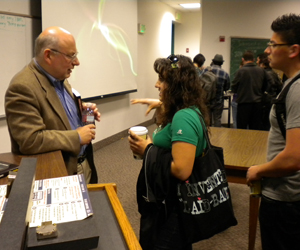Winning and Losing the War on Terror
International terrorism expert Dr. Marc Sageman spoke at SDSU as part of a semester-long lecture series.

While the U.S. fight against terrorism has largely been successful, the war in Afghanistan may already be lost, said Dr. Marc Sageman, an independent researcher specializing in terrorism.
Researching political violence
Sageman’s provocative remark was part of his Feb. 5 lecture, “The Turn to Political Violence.” Through his research, Sageman assists the Western intelligence community in identifying and managing the threats posed by the neo-jihadi terrorists and potential terrorists.
Sponsored by the Charles W. Hostler Institute on World Affairs, Sageman spoke as part of a semester-long lecture series, “Killing for a Higher Cause: Political Violence in a World in Crisis.” Sageman is a forensic and clinical psychiatrist, and his research consists of two components:
- A quantitative analysis of recent terrorist plots
- A socio-psychological analysis of the process whereby healthy political discontent turns into criminal intent to engage in political violence
A look into the mind of a terrorist
Using quantitative methods to identify trends in the 60 most recent terrorist plots, he extrapolates a highly contentious central conclusion—that the main terrorist threat in recent years comes not from al-Qaeda, but from groups loosely affiliated with or merely inspired by al-Qaeda. The majority of terrorist plots fall into this category.
His socio-psychological analysis, drawn from the trials of convicted terrorists, concludes that young men without structured lifestyles that include jobs and/or wives and who have become disillusioned with legitimate countercultural protest groups are more likely to turn to political violence.
According to Sageman, Western counter-terrorist efforts should veer away from hunting down al-Qaeda leaders and focus instead on these countercultural protest groups, dubbed “blobs” by Sageman, in order to identify and monitor those individuals who fit the profile of likely terrorists. A telling indicator is when a smaller group splits from the blob and forms a more radicalized version.
About Sageman
After graduating from Harvard, Sageman obtained an M.D. and a Ph.D. in sociology from New York University. Following a tour as a flight surgeon in the U.S. Navy, he joined the Central Intelligence Agency in 1984, where he was mostly based in Islamabad.
In 1991, he resigned from the agency to return to medicine. Since 1994, he has been in private practice of forensic and clinical psychiatry and has had the opportunity to evaluate about 500 murderers. After 9/11, Sageman collected biographical material on 400 al-Qaeda terrorists and published his research in two books, Understanding Terror Networks and Leaderless Jihad.
As an expert on al-Qaeda and related terrorist organizations, he has consulted with various branches of the U.S. and foreign governments, and lectured at universities worldwide.
About the lecture series
SDSU’s spring lecture series, “Killing for a Higher Cause: Political Violence in a World in Crisis,” takes an in-depth look at political violence and conflict around the world.
To see the entire list of lectures, click here.



